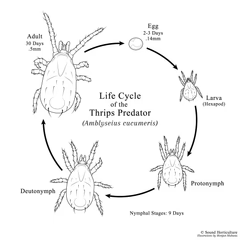Biocontrols for Tropical Plants

Bringing tropical plants indoors has been a trend for many years. Whether your space is so filled with plants there's no room for furniture or you just have a single vibrant green specimen plant, there are many benefits to growing plants indoors. It has been scientifically proven that plants reduce stress levels, boost productivity and improve the quality of the air in our environment. They provide so many positive things, but they also come with challenges, like providing the optimal growing conditions and the unfailing battle against pests and disease. Mimicking nature with biological controls releases natural enemies to manage problems. This approach also reduces chemical use in our environments.
Start your biocontrol program with a good scouting routine. Visually inspect all plants on a regular basis and keep records of which pests are present, when they occurred and on which plants. Always inspect new plant material and consider placing it in quarantine for a short time to watch for any existing pest or disease issues. Be aware that pests may be present in the soil as well, so inspect all parts of the plant. Many biocontrol agents work best preventatively, so create a plan, organize a budget and commit. Read on to find solutions to many common pest problems.
Mealybugs and Scale
These pests damage plants by sucking the sap which causes distortions, stunting and yellowing of foliage. They also produce honeydew, which supports the growth of unsightly sooty molds on leaves and consequently attracts ants. Some biological controls only attack certain species of pests, therefore correct identification is essential.
Biological Control Agents for Mealybug and Scale
Aphytis melinus is a parasite of hard scale. It will attack California red scale, San Jose scale, ivy scale and oystershell scale. Females lay their eggs under the immature scale and can lay over 100 eggs during her two-week lifespan.
Rhyzobius are ladybird beetles that resemble Cryptolaemus, although smaller. They are used for soft and hard scale. Adults and older larvae feed on all scale life stages. Adult females live for two months.
Adalia bipunctata, the two-spotted lady beetle, is a generalist predator that feeds on most soft bodied insects including scale and mealybug. Adults live for two to three months.
Chrysoperla rufilabris, the green lacewing, is a generalist predator. The larvae feed on all types of soft bodied pests and persist for two to three weeks. Also known as ‘aphid lions’ lacewing larvae voraciously attack their prey by seizing them with large, sucking jaws and inject paralyzing venom. The hollow jaws then draw out the body fluids of the pest.
Micromus variegatus, the brown lacewing, is also a generalist predator, but both the larval and adult forms aggressively eat pests. The nocturnal Micromus is active at temperatures down to 39F making it ideal for cool season pest control.
Cryptolaemus montrouzieri, also known as the mealybug destroyer, is a generalist predator. They are most effective when mealybug numbers are high and when conditions are warm and humid. They are most active in sunlight and are not as effective during darker winter months.
Other Measures to control scale and mealybug
Prune out and destroy severely infested branches before releasing biological controls. Mist plants with water to remove honeydew. Spray infested plants with insecticidal soap to reduce pest numbers before releasing biological controls. Soap is most effective on the crawler stage of scales.
Spider Mites
Two-spotted mites, Tetranychus urticae, are the most common mites on ornamentals. Spider mites are often a problem in very warm and dry areas, such as during the summer and on branches nearest a window. Their feeding causes white stippling on the leaves, and in severe infestations the leaves turn yellow and die. Webbing indicates a spider mite infestation.
Biological Control Agents for Spider Mites
Phytoseiulus persimilis is a specialist predator for two-spotted spider mites. Introduce Persimilis at the first sign of spider mite damage, in all infested areas. Distribute them on middle and upper foliage, in early morning. Monitor progress by inspecting new growth weekly to determine whether spider mite damage continues to occur.
Galendromus occidentalis do well under high or low temperatures and are more effective than Persimilis in tree top foliage and on hairy leaves. They feed primarily on spider mite nymphs and adults, but not on eggs and will feed on pollen if mite populations are low.
Amblyseius californicus and Amblyseius fallacis persist better that other species as they also feed on pollen and a variety of small insects and mites, helping them persist over a longer period. Californicus does well in extremely hot conditions and fallacis can reproduce at lower temperatures than other predatory mites.
Other Measures for Spider Mite Control
Mist plants frequently to raise humidity, but do not hose down the foliage, which would dislodge predators. This slows the feeding and reproduction of spider mites making conditions more favorable for predatory mites.
Thrips
Several species of thrips cause problems in tropicals, including western flower thrips (Frankliniella occidentalis) and onion thrips (Thrips tabaci), echinothrips (Echinothrips americanus) and Thrips parvispinus. Thrips damage leaves and flowers by sucking the cell contents, leaving a silvery, stippled and distorted appearance. Western flower thrips can also transmit Tomato Spotted Wilt Virus, which kills some ornamentals. Pesticide resistant strains of this species are common.
Biological Control Agents for Thrips
Stratiolaelaps scimitus is a soil-dwelling mite that feeds on the immature stages of thrips in the soil or growing media. Strats alone cannot control thrips infestations, but it contributes to the effectiveness of biological control when used with other predators. They will also feed on fungus gnat larvae, springtails and root mealybug.
Amblyseius cucumeris feeds on immature stages of thrips as well as pollen. Cucumeris is available in a loose bran carrier, which is sprinkled onto leaves, and in slow-release sachets which are hung on plants. Release predators at the first sign of thrips, or, ideally, before thrips are present on susceptible plants. Establishment of cucumeris takes 4-8 weeks, so start before thrips problems occur.
Orius insidiosus, the minute pirate bug, feeds on all stages of thrips. Orius is most effective from March to September because they do not reproduce if day length is less than 16 hours. Supplemental lighting can remedy this. Release at least 500 Orius at one time and use banker plants like ‘Purple Flash’ peppers to establish a breeding population.
Aphids
Green peach aphid, Myzus persicae can be a serious problem on tropicals. Foxglove aphid, Aulacorthum solani, and potato aphid Macrosiphum euphorbiae, may also occur. Aphids reproduce quickly on favored host plants causing distorted foliage. They also produce honeydew, which coats leaves and allows sooty molds to grow and attracts ants.
Biological Control Agents for Aphids
Aphidius spp. are a group of native parasitic wasps used to control aphids. They are outstanding searchers and can locate new aphid colonies even when aphid populations are low. After the females lay an egg in an aphid, the aphid becomes a swollen brown ‘aphid mummy’ and a new wasp hatches out. Aphidius are selective of their prey, so aphid identification is essential.
Aphidoletes aphidimyza, the aphid midge, is a predator of over 60 species of aphids. The adult female midges lay their eggs near aphid colonies and the resulting orange larvae attack aphids. Use preventatively before aphids appear.
Chrysoperla, Micromus and Adalia are also aphid predators. See above.
Other Measures for Aphid Control
Prune out heavily infested branches, wash aphids off plants with a strong spray of water or apply insecticidal soap sprays before releasing biological controls. Control ants, which may be protecting aphid colonies from predators.
Whitefly
The most common whitefly on tropicals is greenhouse whitefly (Trialeurodes vaporariorum). The feeding of immature whiteflies drops sticky honeydew onto foliage below, which become covered with unsightly sooty mold, reducing the vigor of plants.
Biologicial Control for Whitefly
Encarsia formosa is a tiny wasp that parasitizes immature stages of whitefly. As the wasp develops, the greenhouse whitefly scales gradually turn black. Encarsia are less effective during cool weather and overcast periods and short winter days.
Delphastus catalinae is a small, black, lady beetle. Both adults and larvae feed on whitefly eggs and immature stages. Delphastus is sold as adults and should be applied as soon as whitefly are detected. Delphastus works well with Encarsia because it avoids feeding on parasitized whitefly scale.
Visit our product page for natural solutions to disease with biostimulants and microbial products. Contact Sound Horticulture for a detailed biological control plan for your growing environment, we are always here to help.
Biocontrols for Tropical Plants pdf






Leave a comment